theartsdesk at the Music@Malling Festival | reviews, news & interviews
theartsdesk at the Music@Malling Festival
theartsdesk at the Music@Malling Festival
Bach, Sibelius and child-friendly concerts beneath the Pilgrims' Way
One of the summer’s greatest pleasures has been to confirm an often untested truism: that you may hear some of the finest and rarest music-making in out-of-the-way places.
Music@Malling has certainly put down roots in its fifth year, with the unspoilt "village that thinks it's a town" West Malling as the nerve-centre. Events earlier last week included jazz evenings in which the James Pearson Trio and Claire Martin had played to full houses, and the results of commissioning composer David Horne to write a work based on fairy tales by the Brothers Grimm. Those involved around 1500 schoolchildren in two different churches, choreography featuring two dancers from English National Ballet and Kemp’s well-established small orchestra Chambre Domaine. I did catch the knock-on effect as families flocked to the final concert loosely woven around “Nordic Myths and Legends” with far from merely entertaining pieces including Sibelius’s chamber melodrama version of a masterpiece, The Wood Nymph.
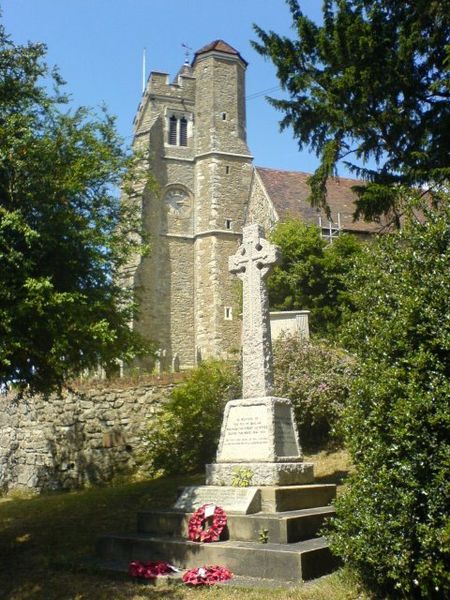 Sibelius and Nielsen were impressively threaded with Bach in the three concerts I attended on Saturday. The aim was to walk between Addington, where the church in true Kent style is some way from the village green on a pretty rise, Birling with its connections to the Nevill family (pictured right) and Trottiscliffe (pronounced “Trosley”), the loveliest of them all just under the Downs where the church feels very much like the end of the road, with prehistoric stones a short walk away.
Sibelius and Nielsen were impressively threaded with Bach in the three concerts I attended on Saturday. The aim was to walk between Addington, where the church in true Kent style is some way from the village green on a pretty rise, Birling with its connections to the Nevill family (pictured right) and Trottiscliffe (pronounced “Trosley”), the loveliest of them all just under the Downs where the church feels very much like the end of the road, with prehistoric stones a short walk away.
The morning light flooding in through the east window of St Margaret’s Addington found its lucid complement in harpsichordist Steven Devine’s performance of Bach’s Italian Concerto. More pronounced chromatic quirks were evident in the C minor Fantasia, BWV906, which had to stand as the core of the programme in the absence of a piece I’d been keenly anticipating from Kemp, Nielsen’s Prelude and Theme with Variations. Why had it vanished? We weren’t told.
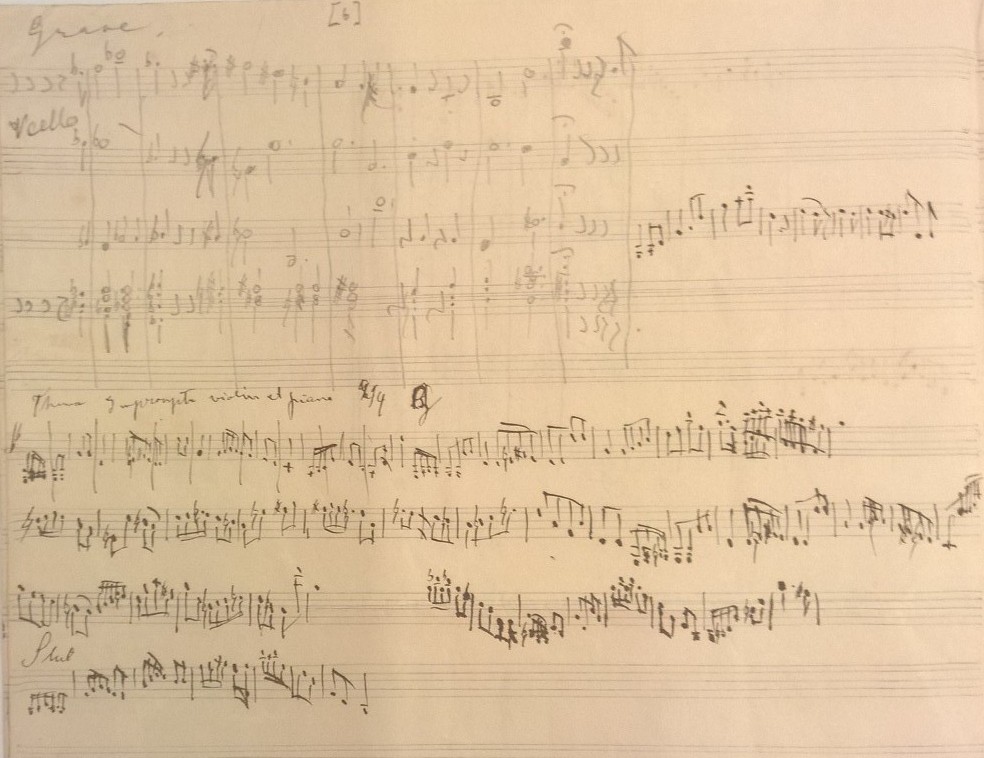 What we did get was a charming spiel about a local connection to Sibelius: Kemp’s inspirational first teacher had in her youth (presumably the early 1950s) written to ask Sibelius if he would compose a piece for her, her sister and orchestra. The reply was typically laconic but kind: “I should love to write a double concerto for you, but unfortunately I no longer compose”. What we had here was a tuneful, danceable boyhood sketch taken from a manuscript Kemp had unearthed in the Helsinki National Library (pictured above; Sibelius was a proficient violinist and wrote for the instrument at all periods of his life). It was interesting to then hear Kemp apply romantic vibrato to Bach’s Violin Sonata in G, BWV 1021, not at all in conflict with Devine’s meaty harpsichord sound (his instrument, he told us, was a 2000 copy of a 1710 Fleischer instrument, German-manufactured to give a more percussive, less floral sound than any of its French counterparts.
What we did get was a charming spiel about a local connection to Sibelius: Kemp’s inspirational first teacher had in her youth (presumably the early 1950s) written to ask Sibelius if he would compose a piece for her, her sister and orchestra. The reply was typically laconic but kind: “I should love to write a double concerto for you, but unfortunately I no longer compose”. What we had here was a tuneful, danceable boyhood sketch taken from a manuscript Kemp had unearthed in the Helsinki National Library (pictured above; Sibelius was a proficient violinist and wrote for the instrument at all periods of his life). It was interesting to then hear Kemp apply romantic vibrato to Bach’s Violin Sonata in G, BWV 1021, not at all in conflict with Devine’s meaty harpsichord sound (his instrument, he told us, was a 2000 copy of a 1710 Fleischer instrument, German-manufactured to give a more percussive, less floral sound than any of its French counterparts.
Vibrato was off the menu two and a half hours later when the excellent Sacconi Quartet in All Saints’ Birling played the chorale conclusion to Bach’s The Art of Fugue as a thoughtful preface to a Sibelius masterpiece, the Voces Intimae Quartet. The loneliness of much of its writing was offset by passionate vibrato reapplied, but never too much so, especially by first violinist Ben Hancox. He took the climax of the entire work, towards the end of the deeply-felt Adagio di molto, very much the emotional centre of the five-movement work, to overwhelming heights. These are (mostly) young musicians with the right wisdom to rise to some extraordinary challenges.
Walking obstacles on the "Bach pilgrimage" meant we only arrived at Birling at the last minute. A crucial subway under the disruptive M26 which separates two of our three churches from the third was flooded. It was no pleasure ploddng along the motorway trying to find a way up or across, eventually climbing over a barbed-wire fence into a field of horses and their tolerant owners who set us back on course.
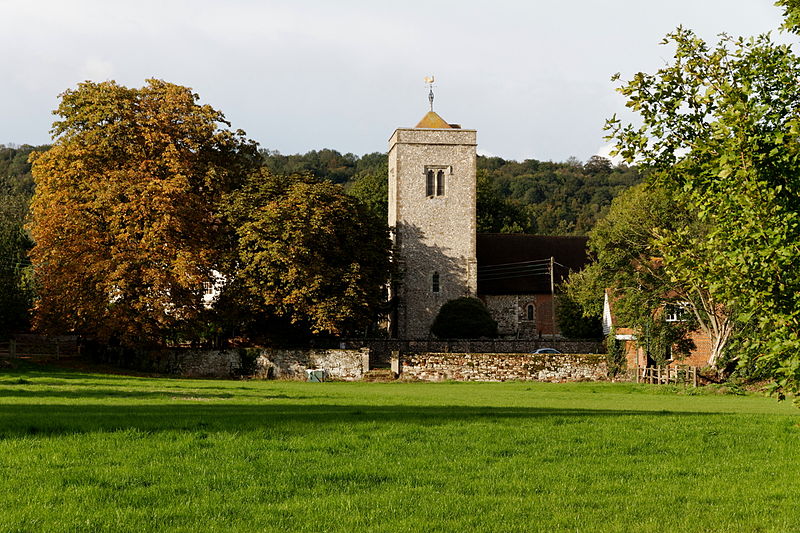 The bonus was to see the fourth of the “Pilgrims’ Way” churches, or at least the outside of St Martin’s Ryarsh, dramatically separated from its village by the motorway and in very poetic seclusion. Much the finest stretch of walking would have been up on to the North Downs ridge to our last destination of the day, Trottiscliffe, but 45 minutes between concerts 2 and 3, so steps need to be traced on a future visit (no problem, as West Malling is only an hour’s train journey from Victoria).
The bonus was to see the fourth of the “Pilgrims’ Way” churches, or at least the outside of St Martin’s Ryarsh, dramatically separated from its village by the motorway and in very poetic seclusion. Much the finest stretch of walking would have been up on to the North Downs ridge to our last destination of the day, Trottiscliffe, but 45 minutes between concerts 2 and 3, so steps need to be traced on a future visit (no problem, as West Malling is only an hour’s train journey from Victoria).
At least there was time to take in the glorious surroundings of St Peter and St Paul’s Trottiscliffe (pictured above right), a small and complete Norman church which was a travellers’ resting place on descending from the Pilgrims’ Way. Its gem is a disproportionate but wonderfully eccentric 1775 pulpit originally designed by Henry Keene for Westminster Abbey, a wooden palm tree supporting the sounding board just below the church roof. Here the music, too, was of the essence: consummate Finnish flautist Sami Junnonen, a major player during the festval’s earlier events, in Bach’s A major Partita, Debussy’s Syrinx and his own, staggering arrangement of the greate Ciaccona from the D minor Partita, all the violin’s passing notes sounding rich and rare on the golden flute.
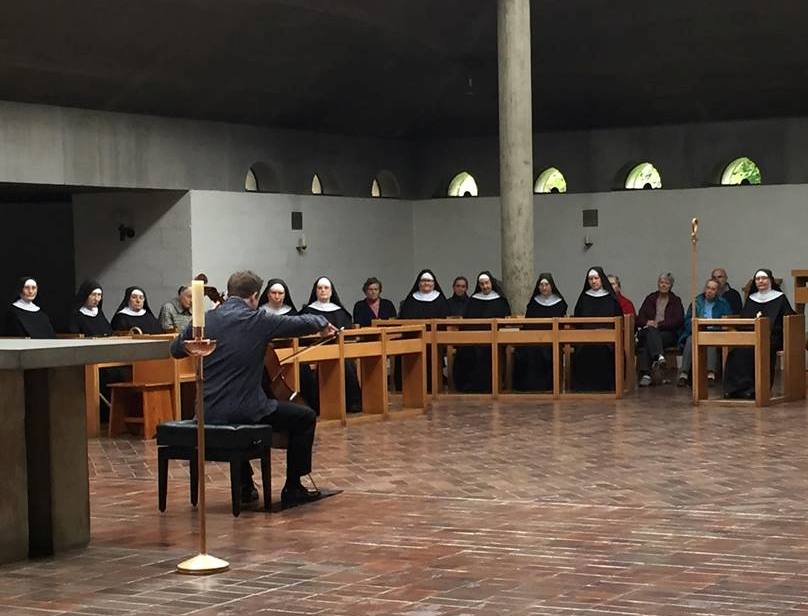 The more I found out about the very unusual venues of West Malling, the more I wished I’d been there during the week, not least to share the experience of Richard Harwood’s three Bach Cello Suites programmes in the otherwise impenetrable chapel of St Mary’s Abbey with the closed order of nuns (pictured by David Horne. The chapel was built in the 1960s; the rest of the buildings in the generous grounds range from Norman ruins to the 18th century house of ruin-lover Frazer Honeywood). Pianist Sophia Rahman, a much admired acquaintance from the Pärnu Festival, told me the nuns had also used a secret route to attend the Friday lunchtime concert of Debussy and Ravel in which she’d participated in the medieval barn now owned by the Pilsdon Community, a valuable rehabilitation centre which is only one of several important retreats in the area.
The more I found out about the very unusual venues of West Malling, the more I wished I’d been there during the week, not least to share the experience of Richard Harwood’s three Bach Cello Suites programmes in the otherwise impenetrable chapel of St Mary’s Abbey with the closed order of nuns (pictured by David Horne. The chapel was built in the 1960s; the rest of the buildings in the generous grounds range from Norman ruins to the 18th century house of ruin-lover Frazer Honeywood). Pianist Sophia Rahman, a much admired acquaintance from the Pärnu Festival, told me the nuns had also used a secret route to attend the Friday lunchtime concert of Debussy and Ravel in which she’d participated in the medieval barn now owned by the Pilsdon Community, a valuable rehabilitation centre which is only one of several important retreats in the area.
It was certainly worth travelling back down to West Malling on Sunday afternoon for the final “Family Concert”. I don’t suppose many folk can boast of having heard two performances of Sibelius’s melodrama-version Wood Nymph in a year. I’d caught it first in Bergen, in an unrepeatable programme including even rarer Sibelius melodramas masterminded by Leif Ove Andsnes. This one made even more sense to me, at any rate, since the narration was in English, not Swedish, and vigorously delivered by actor, cellist and baritone Matthew Sharp. He definitely achieved a first by holding his hitherto delightfully obstreperous son in his arms as he delivered.
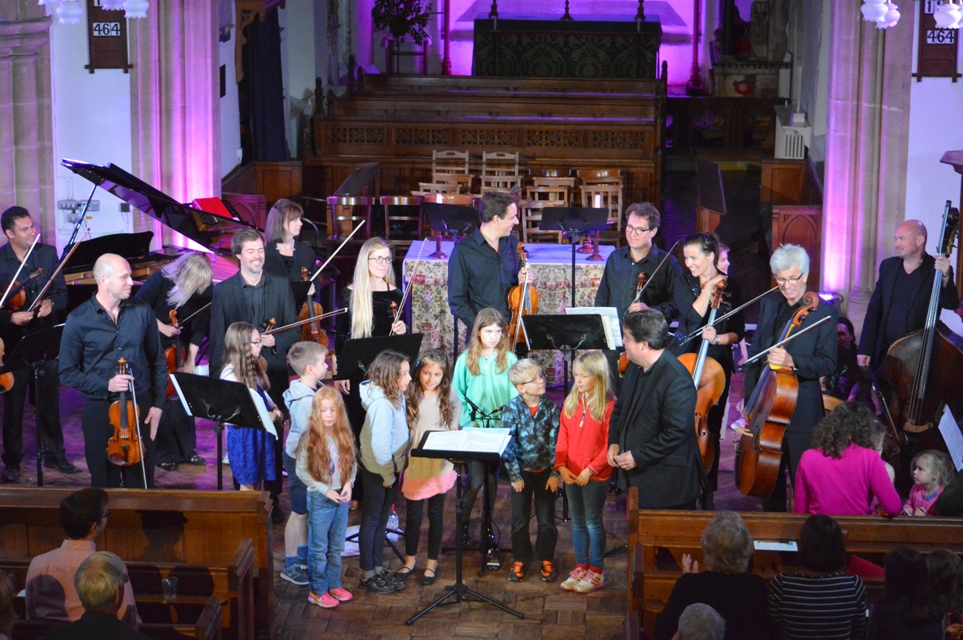
The children (some of them at the end pictured above by Shani Hancock) seemed to like it. Once Sharp's dialogue ceased after the interval and it became apparent that we weren't going to hear another melodrama rarity I would have travelled a long way to catch, Grieg’s The Mountain Thrall, youthful engagement had to find another outlet during the weird magic of Sibelius’s Rakastava (The Lover, a first in concert for me) and very late, light Suite for Violin and Orchestra. So the kids were invited to sit within the orchestra, which they seemed very happy to do. The strings resonated beautifully in the acoustic – a wooden floor in a church makes all the difference – and a sizeable audience went home happy. Next year, you should make a least a day of it down there; there aren’t many things more pleasurable than quality music-making complemented by fine churches and perfect early autumn weather in the country.
Share this article
The future of Arts Journalism
You can stop theartsdesk.com closing!
We urgently need financing to survive. Our fundraising drive has thus far raised £49,000 but we need to reach £100,000 or we will be forced to close. Please contribute here: https://gofund.me/c3f6033d
And if you can forward this information to anyone who might assist, we’d be grateful.

Subscribe to theartsdesk.com
Thank you for continuing to read our work on theartsdesk.com. For unlimited access to every article in its entirety, including our archive of more than 15,000 pieces, we're asking for £5 per month or £40 per year. We feel it's a very good deal, and hope you do too.
To take a subscription now simply click here.
And if you're looking for that extra gift for a friend or family member, why not treat them to a theartsdesk.com gift subscription?
more Classical music
 First Person: Manchester Camerata's Head of Artistic Planning Clara Marshall Cawley on questioning the status quo
Five days of free events with all sorts of audiences around Manchester starts tomorrow
First Person: Manchester Camerata's Head of Artistic Planning Clara Marshall Cawley on questioning the status quo
Five days of free events with all sorts of audiences around Manchester starts tomorrow
 Goldscheider, Brother Tree Sound, Kings Place review - music of hope from a young composer
Unusual combination of horn, strings and electronics makes for some intriguing listening
Goldscheider, Brother Tree Sound, Kings Place review - music of hope from a young composer
Unusual combination of horn, strings and electronics makes for some intriguing listening
 theartsdesk Q&A: composer Donghoon Shin on his new concerto for pianist Seong-Jin Cho
Classical music makes its debut at London's K-Music Festival
theartsdesk Q&A: composer Donghoon Shin on his new concerto for pianist Seong-Jin Cho
Classical music makes its debut at London's K-Music Festival
 Helleur-Simcock, Hallé, Wong, Bridgewater Hall, Manchester review - moving lyricism in Elgar’s concerto
Season opener brings lyrical beauty, crisp confidence and a proper Romantic wallow
Helleur-Simcock, Hallé, Wong, Bridgewater Hall, Manchester review - moving lyricism in Elgar’s concerto
Season opener brings lyrical beauty, crisp confidence and a proper Romantic wallow
 Kohout, Spence, Braun, Manchester Camerata, Huth, RNCM, Manchester review - joy, insight, imagination and unanimity
Celebration of the past with stars of the future at the Royal Northern College
Kohout, Spence, Braun, Manchester Camerata, Huth, RNCM, Manchester review - joy, insight, imagination and unanimity
Celebration of the past with stars of the future at the Royal Northern College
 Jansen, LSO, Pappano, Barbican review - profound and bracing emotional workouts
Great soloist, conductor and orchestra take Britten and Shostakovich to the edge
Jansen, LSO, Pappano, Barbican review - profound and bracing emotional workouts
Great soloist, conductor and orchestra take Britten and Shostakovich to the edge
 Jakub Hrůša and Friends in Concert, Royal Opera review - fleshcreep in two uneven halves
Bartók kept short, and a sprawling Dvořák choral ballad done as well as it could be
Jakub Hrůša and Friends in Concert, Royal Opera review - fleshcreep in two uneven halves
Bartók kept short, and a sprawling Dvořák choral ballad done as well as it could be
 Hadelich, BBC Philharmonic, Storgårds, Bridgewater Hall, Manchester review - youth, fate and pain
Prokofiev in the hands of a fine violinist has surely never sounded better
Hadelich, BBC Philharmonic, Storgårds, Bridgewater Hall, Manchester review - youth, fate and pain
Prokofiev in the hands of a fine violinist has surely never sounded better
 Monteverdi Choir, ORR, Heras-Casado, St Martin-in-the-Fields review - flames of joy and sorrow
First-rate soloists, choir and orchestra unite in a blazing Mozart Requiem
Monteverdi Choir, ORR, Heras-Casado, St Martin-in-the-Fields review - flames of joy and sorrow
First-rate soloists, choir and orchestra unite in a blazing Mozart Requiem
 Cho, LSO, Pappano, Barbican review - finely-focused stormy weather
Chameleonic Seong-Jin Cho is a match for the fine-tuning of the LSO’s Chief Conductor
Cho, LSO, Pappano, Barbican review - finely-focused stormy weather
Chameleonic Seong-Jin Cho is a match for the fine-tuning of the LSO’s Chief Conductor
 Classical CDs: Shrouds, silhouettes and superstition
Cello concertos, choral collections and a stunning tribute to a contemporary giant
Classical CDs: Shrouds, silhouettes and superstition
Cello concertos, choral collections and a stunning tribute to a contemporary giant
 Appl, Levickis, Wigmore Hall review - fun to the fore in cabaret and show songs
A relaxed evening of light-hearted fare, with the accordion offering unusual colours
Appl, Levickis, Wigmore Hall review - fun to the fore in cabaret and show songs
A relaxed evening of light-hearted fare, with the accordion offering unusual colours

Add comment